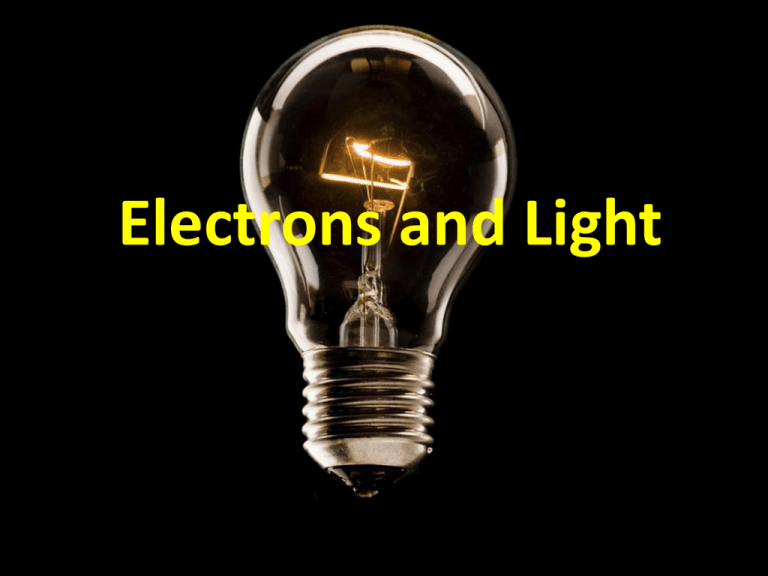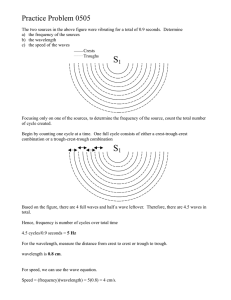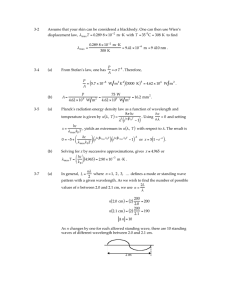Notes Electrons and light
advertisement

Electrons and Light Light’s relationship to matter • Atoms can absorb energy, but they must eventually release it • When atoms emit energy, it is released in the form of light = emission spectrum • Atoms don’t absorb or emit all colors, only very specific wavelengths; the spectrum of wavelengths can be used to identify the element Line Spectra= specific wavelengths are emitted; characteristic of atoms • Light has particle-like behavior • Photons (light) come from electrons falling from high electron orbits to low orbits. The Wave Description of Light • Light must be a wave, because… –Light is refracted in lenses. –Light can be diffracted. Light is a Particle • Light can travel through the vacuum of space, but waves can’t travel in a vacuum. So light must be a particle! • Light is Both – light is both a wave and a particle. Packets of light we call photons. • Visible light is a kind of electromagnetic radiation. • Electromagnetic radiation is a form of energy that exhibits wavelike behavior as it travels through space. • Examples of EMR include X rays, ultraviolet light, infrared light, microwaves, and radio waves. • All forms of EMR move at a constant speed. – 3.0 x 108 m/s = speed of light (c) 1. Which color of light has a longer wavelength, green or yellow? ______________ 2. Which color of light has a higher frequency? Violet or Red? ______________ 3. Which color of light has the highest energy? Violet or Red? 4. What is the wavelength of red light? ______________ 5. What is the wavelength of violet light? _____________ Characteristics of a Wave • Significance of wave motion is its repetitive nature: waves have measurable properties of wavelength and frequency. • Wavelength is the distance between corresponding points on adjacent waves. • Frequency is the number of waves that pass a given point in a specific time (usually one second). Which wave has a higher frequency? ________ A B Frequency and wavelength are mathematically related V=f x λ V = velocity F = frequency λ = wavelength EX 1: A wave has a frequency of 30 Hz and a wavelength of 5 m, what is its velocity? EX 2: A wave has a frequency of 10 Hz and a wavelength of .01 m, what is its velocity? • Scientists in the early 20th century, Max Planck and Albert Einstein showed that electromagnetic radiation was composed of particles we call photons (photons are particles of light energy). • Each wavelength of light has photons that have a different amount of energy. • the longer the wavelength, the lower the energy of the photons. Dual Nature of Light • From Einstein's famous equation E = mc2 E = mc2 m=E c2 E= energy m= mass c2 = speed of light • Energy has an apparent mass. • The apparent mass of a photon depends on its wavelength. Einstein (1905) • Explained the photoelectric effect by proposing that EMR is absorbed by matter only in whole numbers of photons. • Concluded that light has properties of both waves and particles “wave-particle duality” • A photon carries a quantum of energy. • The energy of a photon is proportional to its frequency. E = h E: energy (J, joules) h: Planck’s constant (6.6262 10-34 J·s) : frequency (Hz) Practice EX 1: Find the energy of a red photon with a frequency of 4.57 1014 Hz. GIVEN: E=? = 4.57 1014 Hz h = 6.6262 10-34 J·s Solve: EX 2: Find the energy of a photon with a frequency of 3.55 1014 Hz. GIVEN: E=? = 4.57 1014 Hz h = 6.6262 10-34 J·s





